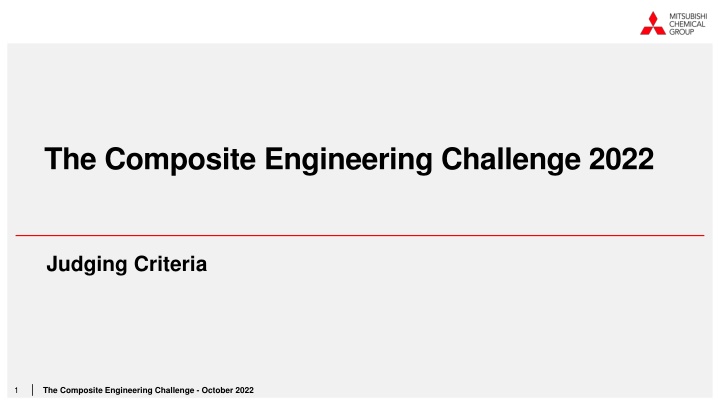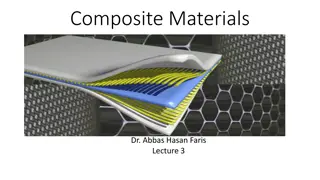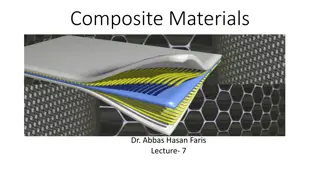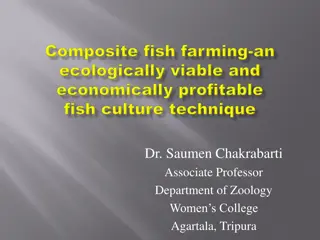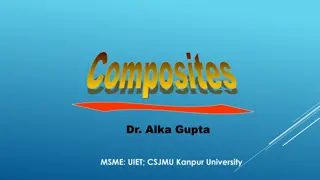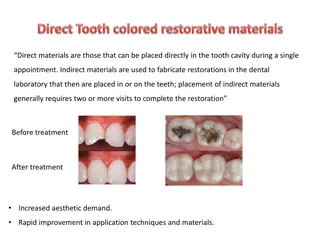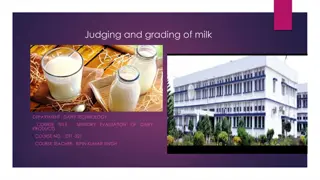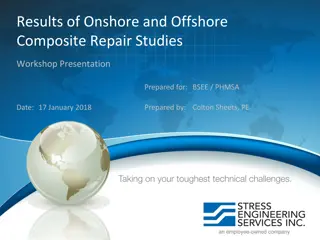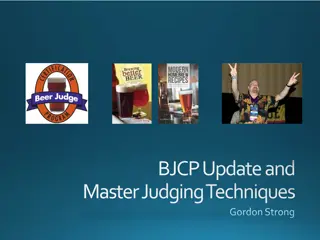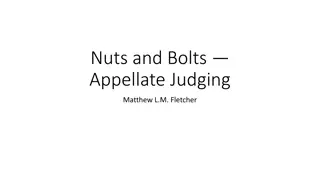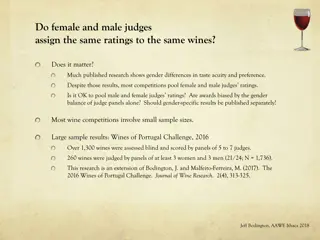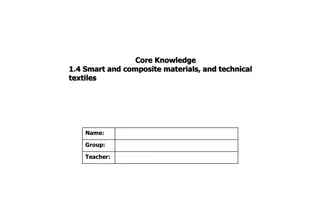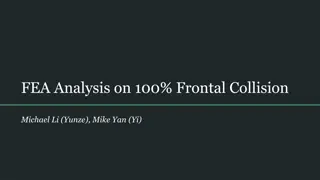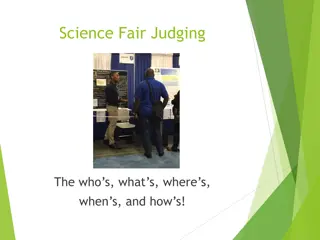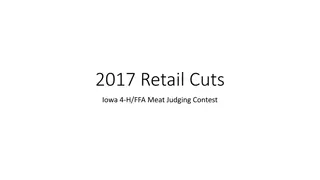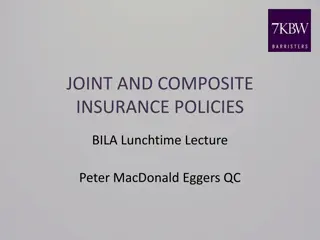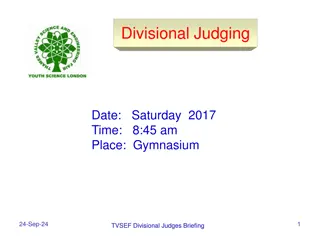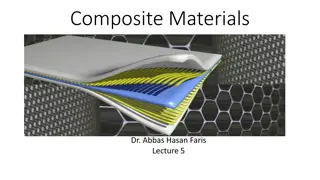Composite Engineering Challenge 2022 Judging Criteria
All project submissions will be evaluated based on technical feasibility, scalability, commercial feasibility, and sustainability. Learn about creating Minimum Viable Products (MVPs) for testing and iterating. Understand Technical Readiness Levels (TRL) and Manufacturing Readiness Levels (MRL) for assessing product maturity.
Uploaded on Mar 12, 2025 | 0 Views
Download Presentation

Please find below an Image/Link to download the presentation.
The content on the website is provided AS IS for your information and personal use only. It may not be sold, licensed, or shared on other websites without obtaining consent from the author.If you encounter any issues during the download, it is possible that the publisher has removed the file from their server.
You are allowed to download the files provided on this website for personal or commercial use, subject to the condition that they are used lawfully. All files are the property of their respective owners.
The content on the website is provided AS IS for your information and personal use only. It may not be sold, licensed, or shared on other websites without obtaining consent from the author.
E N D
Presentation Transcript
The Composite Engineering Challenge 2022 Judging Criteria 1 The Composite Engineering Challenge - October 2022
All you need to know before submitting your project All submissions will be judged based on several criteria: 1. Technical Feasibility 2. Scalability (manufacturing and team) 3. Commercial Feasibility 4. Sustainability All criteria are equally important for the judging process. Are you still in the idea phase or have advanced further and ready to launch your product into the world? Startups and scaleups typically test their first (functional) prototypes , so called beta-versions, with a selective set of customers to get valuable feedback in an early stage of your development. This approach reduces time-to-market and avoids wasting resources (time and money). A great way to check both technical and commercial feasibility (in an early stage of development) is to create an MVP. This is a Minimum Viable Product, let s say 60-80% ready that you re going to test with a small audience to get early feedback. This first step is followed by multiple iteration loops. Typically, the final product (based on customer feedback) is not what you envisioned at the start of your journey. We recommend reading The Lean Startup by Eric Ries (https://leanstartup.co/team/eric-ries/) to get more insights in this approach. CONFIDENTIAL 2 The Composite Engineering Challenge - October 2022
Technical feasibility : TRL Technical feasibility is judged by a team of technical experts who assess the technical readiness, often referred to as Technical Readiness Level (TRL) and the manufacturing scalability is assessed according to the Manufacturing Readiness Level (MRL). TRL 9: Qualified system with proof of successful use. Actual system proven in operational environment (competitive manufacturing). TRL 8: Qualified system with proof of functionality in the area of application. Teams that can show customer testing or have entered in commercial sales (of beta-versions or beyond) are favored, as it increases their readiness level. TRL 7: Prototype in use (in operational environment). TRL 6: Prototype in operational environment. Technology demonstrated in relevant environment. Although the TRL scale was developed by NASA, it has since been adopted by many other organizations, such as the European Union, allowing for easy translation into multiple industry sectors. The US Department of Defense (DOD), the Department of Energy (DOE), the Air Force, the oil and gas industry and the European Space Agency (ESA) in Europe , all use the TRL scale. NASA introduced the TRL to enable more effective assessment and communication of the maturity of new technologies and it might serve you to assess your product as well, even if your product is not intended for aerospace. TRL 5: Test setup in operational environment. Technology validated in industrially relevant environment. TRL 4: Experimental setup in the laboratory. Technology validated in lab / testing environment. TRL 3: Demonstrating the functionality of a technology. Experimental proof-of-concept. TRL 2: Description of the application of a technology TRL 1: Observation and description of the functional principle Source: https://de.wikipedia.org/wiki/Technology_Readiness_Level, https://en.wikipedia.org/wiki/Technology_readiness_level CONFIDENTIAL 3 The Composite Engineering Challenge - October 2022
Scalability MRL The manufacturing readiness level can be assessed according to the following definitions. MRL Definition Description MRL Definition Description Basic manufacturing implications identified Capability to produce systems, subsystems or components in a production representative environment. Basic research expands scientific principles that may have manufacturing implications. The focus is on a high-level assessment of manufacturing opportunities. The research is unfettered. Detailed design is underway. Material specifications are approved. Materials available to meet planned pilot line build schedule. Manufacturing processes and procedures demonstrated in a production representative environment. Detailed producibility trade studies and risk assessments underway. Cost models updated with detailed designs, rolled up to system level and tracked against targets. Unit cost reduction efforts underway. Supply chain and supplier Quality Assurance assessed. Long lead procurement plans in place. Production tooling and test equipment design and development initiated. 1 7 Invention begins. Manufacturing science and/or concept described in application context. Identification of material and process approaches are limited to paper studies and analysis. Initial manufacturing feasibility and issues are emerging. Manufacturing concepts identified 2 Conduct analytical or laboratory experiments to validate paper studies. Experimental hardware or processes have been created but are not yet integrated or representative. Materials and/or processes have been characterized for manufacturability and availability but further evaluation and demonstration is required. Pilot line capability demonstrated. Ready to begin low rate production. Detailed system design essentially complete and sufficiently stable to enter low rate production. All materials are available to meet planned low rate production schedule. Manufacturing and quality processes and procedures proven in a pilot line environment, under control and ready for low rate production. Known producibility risks pose no significant risk for low rate production. Engineering cost model driven by detailed design and validated. Supply chain established and stable. Industrial Capabilities Assessment for Milestone C completed. Manufacturing proof of concept developed 3 8 Required investments, such as manufacturing technology development identified. Processes to ensure manufacturability, producibility and quality are in place and are sufficient to produce technology demonstrators. Manufacturing risks identified for prototype build. Manufacturing cost drivers identified. Producibility assessments of design concepts have been completed. Key design performance parameters identified. Special needs identified for tooling, facilities, material handling and skills. Capability to produce the technology in a laboratory environment. Low rate production demonstrated. Capability in place to begin Full Rate Production. Major system design features are stable and proven in test and evaluation. Materials are available to meet planned rate production schedules. Manufacturing processes and procedures are established and controlled to three-sigma or some other appropriate quality level to meet design key characteristic tolerances in a low rate production environment. Production risk monitoring ongoing. Low Rate Initial Production cost goals met, learning curve validated. Actual cost model developed for Full Rate Production environment, with impact of Continuous improvement. 4 9 Manufacturing strategy refined and integrated with Risk Management Plan. Identification of enabling/critical technologies and components is complete. Prototype materials, tooling and test equipment, as well as personnel skills, have been demonstrated on components in a production relevant environment, but many manufacturing processes and procedures are still in development. Manufacturing technology development efforts initiated or ongoing. Producibility assessments of key technologies and components ongoing. Cost model based upon detailed end-to-end value stream map. Capability to produce prototype components in a production relevant environment. Full rate production demonstrated and lean production practices in place. This is the highest level of production readiness. Engineering/design changes are few and generally limited to quality and cost improvements. System, components or items are in rate production and meet all engineering, performance, quality and reliability requirements. All materials, manufacturing processes and procedures, inspection and test equipment are in production and controlled to six-sigma or some other appropriate quality level. Full rate production unit cost meets goal, and funding is sufficient for production at required rates. Lean practices well established and continuous process improvements ongoing. 5 10 Source: https://en.wikipedia.org/wiki/Manufacturing_readiness_level CONFIDENTIAL 4 The Composite Engineering Challenge - October 2022
Scalability : team Team - Besides the production technology, we are highly interested in the team behind your submission. Do you have the right team, the right competence and partners onboard to execute within a certain timeframe? This typically increases with the maturity of your company; from single entrepreneur to start-up to scale-up and beyond. Not having all competences in place yet is not an invalidating criteria, because you will get access to our ecosystem and partners that will support you (incl. funding). Having the passion and drive to take it all-the-way is key. Intellectual property (IP) - Owning the intellectual property of your solution is an advantage or as a minimum having done the check that you are not infringing anybody s patent. Your work nor its use should infringe the intellectual property rights of any person. Neither the Advanced Materials division of Mitsubishi Chemical Group nor its partners will claim any Intellectual property rights over the content that you submit and your submission does not constitute invention assignment. CONFIDENTIAL 5 The Composite Engineering Challenge - October 2022
Commercial Feasibility Commercial feasibility depends largely on your business model. Often the commercial feasibility is directly linked to the uniqueness or differentiation potential or the Value Proposition and although very important, we take a more holistic approach and look into the entire business model. Transactional, service based and circular business models (or elements thereof) are all welcomed in our Engineering Challenges. To check the level of differentiation potential and get reflection on your brand positioning, we advise you to read the book Find your Zag by Marty Neumeier (https://www.martyneumeier.com/), which is easily digestible and includes some practical guidance. To ensure that you covered all elements to build your business model, we advise to look at the Business Model Canvas by Alex Osterwalder (https://www.alexosterwalder.com/). Other elements that will be considered are how radical your solutions are (incremental change, redesign or new to the world), the type of industry (existing or new) and the global reach. CONFIDENTIAL 6 The Composite Engineering Challenge - October 2022
SUSTAINABILITY Sustainability is a large playing field and is considered as one of the main judging criteria. This may include solutions that are good for the well-being of our society (for example assistive technologies, like wheelchairs and prosthetics), reducing waste, design for recycling, reducing energy during production, improving fuel efficiency by light-weighting or friction reduction, extending the lifetime of a product or promoting circular economy. Are you able to quantify the impact of your technology/service or product? For example: 1. Fuel economy improvement of x% by light weighting with x%, resulting in a CO2emission reduction of x%. 2. Close-the-loop systems to avoid landfill and re-use of valuable resources. 3. Reduced energy consumption due to light weighting (robotics, drones, mobility, ) 4. Extended range of electric powered mobility concepts We strongly believe in giving back than taking. Solutions that take these elements into account are typically ranked as being more future-proof with a higher chance of long term success in the market. A quantification of the reduction of the carbon footprint and CO2emission savings (vs the incumbent solution in the market) can be a strong selling argument. Our experts in the field of Life Cycle Assessments (LCA) are part of our jury expert panel and are part of our ecosystem. CONFIDENTIAL 7 The Composite Engineering Challenge - October 2022
